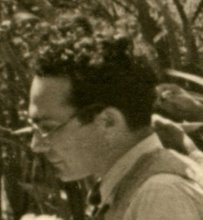 Helena Rasiowa * Curriculum Vitae * Algebraic Logic * Mathematical Foundations of Computer Science * Bibliography
Helena Rasiowa * Curriculum Vitae * Algebraic Logic * Mathematical Foundations of Computer Science * BibliographyHelena Rasiowa
[PDF] A Tribute to Professor Helena Rasiowa
Rasiowa summary * Full MacTutor biography
Helena Rasiowa - Wikipedia, the free encyclopedia
*
Eminent visitors were frequently seen at Monteiro’s Institute. Jean Porte gave an advanced course on mathematical logic and mechanical calculations based on his recent lectures at the Institute Poincaré in Paris; David Mackinson discussed modal Logic; Alan Rose advanced topics in Logic; H. Bauer representation problems in Analysis; Paulo Ribenboim ordered groups; Kiyoshi Iseki topological vector spaces; George Alexits gave master classes on topics of trigonometric series which resulted in a beautiful set of notes which was printed twice. The Institute received the influence of the Polish school of Logic through two of its main exponents of that time: Helena Rasiowa and Roman Sikorski. Many other visitors from abroad or from other Argentinian universities gave courses, short series of lectures or seminars.
[De] Eduardo L. Ortiz: Professor António Monteiro and contemporary mathematics in Argentina.
*
Invita al Instituto a destacados matemáticos de ese momento. Los primeros en llegar fueron dos profesores de la escuela polaca de lógica: Helena Rasiowa y Roman Sikorski, en 1958. Makoto Itoh y Paulo Ribenboim en 1959, Georges Alexits (Budapest), Jean Porte, Federico Gaeta y Orlando Villamayor en 1960 y Mischa Cotlar y Kiyoshi Iseki, en 1963.
[De] E. Fernández Stacco: António A. Monteiro (31/05/1907-29/10/80).
*
De 1958 a 1974 visitaram o Instituto, apesar das diversas dificuldades, para dar cursos e/ou conferências aproximadamente 60 Professores, entre eles: R. Sikorski, H. Rasiowa, A. Diego, O. Dodera, M. Itoh, P. Ribenboim, O. E. Villamayor, G. Alexits, J. Porte, F. Gaeta, M. Tourasse Teixeira, J. Dieudonné, R. L. Gomes, E. Zarantonello, W. Damköler , M. Cotlar, K. Iseki, B. Vauquois, E. Oklander, L. Santaló, E. Roxin, L. Cesari, P. Révész, A. Rose, J. C. Boussard, A. Micali, N. da Costa, D. Makinson, E. Gentile, E. García Camarero, H. Bauer, C. Segovia, R. Panzone, A. Benedek, E. Ortiz, J. Tirao, M. Auslander, H. Bass, C. Wall, M. Harada, E. Cabaña, I. Vincze, os quais cobriram uma ampla gama de especialidades dentro da matemática. Isto mostra a preocupação de António Monteiro por um desenvolvimento integral da matemática em Bahía Blanca, e não somente pelos temas que particularmente estudava. Alguns de estes Professores ficaram definitivamente em Bahía Blanca, e outros ficaram por um certo tempo.
[De] Luiz F. Monteiro: Contribuição Matemática do Professor Dr. António A. R. Monteiro.
*
El interés de Monteiro en álgebra de la lógica se acrecienta después de la visita de Helena Rasiowa y Roman Sikorski a Bahía Blanca en 1958. Durante esta visita Rasiowa expuso sobre los sistemas algebraicos correspondientes a la lógica constructiva con negación fuerte considerada por David Nelson. Estas álgebras fueron llamadas N-lattices o álgebras casi-seudo-booleanas por Rasiowa y posteriormente, álgebras de Nelson por Monteiro. Una estructura subyacente a las álgebras de Nelson son las álgebras de De Morgan (o álgebras casi booleanas en la nomenclatura de Rasiowa).
[De] Roberto Cignoli: La Obra Matemática de António Monteiro.
*
Throughout the study of Boolean and Heyting algebras, Monteiro became interested in the algebraic aspects of logic, this interest having been aroused by direct contact with Roman - Sikorski and Helena Rasiowa when they visited Bahía Blanca in 1958. Monteiro applied his mathematical experience to the study of algebraic systems related to non-classical logics. He was convinced that the algebraic methods in logic would have important technological applications in the future, as a consequence of the development of computers. In view of such prospective applications, he tried to use finitistic and combinatorial methods in studying classes of algebras, whenever possible.
...
In the same vein, he determined the structure of the finite De Morgan and Nelson algebras. Monteiro investigated in depth the structure of Nelson algebras (introduced by H. Rasiowa as the algebraic counterparts of the constructive logic with strong negation considered by Nelson and Markhoff), and he proved that the class of semi-simple Nelson algebras coincides with the class of algebras corresponding to three-valued Lukasiewicz logics. Thus he showed that, from the algebraic point of view, the three-valued Lukasiewicz logic stands in the same relation to constructive logic with strong negation as classical logic does to intuitionistic logic.
[De] Roberto Cignoli: Antonio Monteiro, 1907-1980.




